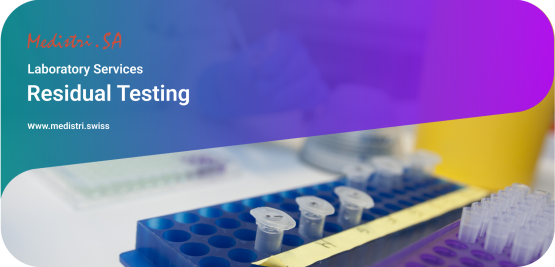(Download: Residual Testing in PDF by Medistri)
Biocompatibility failures and complications can occur from contaminates on medical devices. These can come from cleaning, disinfection, or manufacturing operations. Manufacturers should set acceptable residue levels based on device use and patient contact.
Residual testing is a method of analysing the chemical residues that may remain on a medical device after it has been exposed to a sterilisation process. Residues can affect the biocompatibility, functionality and safety of the medical device, and potentially harm the patient or user. Therefore, it is important to ensure that the residues are within acceptable limits according to the relevant standards and regulations.
Residual testing is important because it helps to ensure the safety and quality of medical devices that are sterilised by different processes. Residual testing can detect and measure the chemical residues that may remain on the device after sterilisation, and can help to reduce or eliminate them if they are above the acceptable limits. Residual testing can also help to comply with the relevant standards and regulations that govern the sterilisation industry. Residual testing is a vital part of quality control and validation for medical devices that are intended for patient contact.
There are two different methods for EO residual testing: simulated-use extraction and exhaustive extraction.
✔ Simulated-use extraction is a method that mimics the actual use of the device by extracting the residues with a suitable solvent under specified conditions. This method is used to determine the amount of residues that may be released from the device during its intended use.
✔ Exhaustive extraction is a method that removes all the residues from the device by using multiple solvents under extreme conditions. This method is used to determine the total amount of residues that are present on the device after sterilisation.
The most common analytical technique for measuring EO and ECH residues is gas chromatography (GC) or headspace analysis (HS).
👉 GC is a technique that separates and quantifies the components of a gas mixture by passing it through a column with a detector.
👉 HS is a technique that analyses the vapour phase of a sample by heating it in a sealed vial and injecting it into a GC system. Both techniques can provide accurate and sensitive results for EO and ECH residues.
ISO 10993-7 (2008) is an international standard that specifies the allowable limits for residual ethylene oxide and ethylene chlorohydrin in individual EO-sterilized medical devices, as well as the procedures for the measurement and compliance of these residuals. Ethylene oxide (EO) is a gas that is widely used to sterilize medical devices, but it can also leave behind harmful residues that can cause irritation, inflammation, or allergic reactions in patients.
Ethylene chlorohydrin is a by-product of EO sterilization that can also have toxic effects. Therefore, it is important to ensure that the levels of these residuals are within safe limits before using the sterilized devices.
ISO 10993-7 (2008) provides guidance on how to determine the allowable limits for different types of devices, based on factors such as the device category, the exposure duration, the body weight, and the surface area of the patient. It also describes methods for sampling, testing, and reporting the results of EO sterilization residuals. The standard is intended to help manufacturers, regulators, and users of EO-sterilized medical devices to ensure the safety and quality of their products.
In 2019, we’ve seen an amendment to this standard, which specifies the allowable limits for residual ethylene oxide and ethylene chlorohydrin in individual EO-sterilized medical devices, as well as the procedures for the measurement and compliance of these residuals. The amendment clarifies the applicability of the allowable limits for neonates and infants. It states that the allowable limits for neonates and infants are the same as those for adults, unless there is a specific justification based on a risk assessment.
The amendment also provides some guidance on how to perform such a risk assessment, taking into account factors such as the device category, the exposure duration, the body weight, and the surface area of the patient. The amendment aims to harmonize the requirements for EO sterilization residuals with other international standards and regulations, such as those from the European Union and the United States. The amendment is effective since December 2019 and applies to all EO-sterilized medical devices that are intended for use in neonates and infants.
✔ Medistri GMP Accredited In-House Laboratory in Switzerland is certified with ISO 17025.
👉 ISO 17025 is a standard that sets the criteria for testing and calibration laboratories to ensure their quality and reliability. It is useful for biocompatibility testing of medical devices, as it helps laboratories to follow the specific ISO standards, such as ISO 10993-7.
Residual testing is an essential part of quality control and validation for the sterilisation industry. It helps to ensure that the medical devices are safe and effective for their intended use and patient contact. Medistri can perform Ethylene Oxide Residual Analysis in our GMP Accredited In-House laboratory in Switzerland to analyse and demonstrate the safety of your sterile medical device.
🎯 To learn more about Medistri’s Residual Testing, visit on our website here or directly contact our team at contact@medistri.swiss.
- The Medistri Team
#Medistri
